Optimization Design of Asphalt Mixture Composite Reinforced with Calcium Sulfate Anhydrous Whisker and Polyester Fiber Based on Response Surface Methodology
Abstract
1. Introduction
2. Materials and Methods
2.1. Materials
2.2. Sample Preparation of APCRA
2.3. Testing Methods
2.3.1. Marshall Test
2.3.2. Indirect Tensile Test
2.4. Design of Experiments
3. Results and Discussion
3.1. Statistical Modeling
3.2. Diagnostics Analyses
3.3. Analysis of Response Surfaces
3.3.1. Analysis of AV
3.3.2. Analysis of MS
3.3.3. Analysis of STS
3.3.4. Analysis of FTS
3.4. Muti-Objective Optimization and Validation of Model
4. Conclusions
- (1)
- It is practicable to optimize design of APCRA using CCC to obtain better low-temperature performance. The optimal design parameters of APCRA are asphalt aggregate ratio of 4.0%, ACSW content of 10.8%, and polyester fiber content of 0.4%.
- (2)
- The inter-reaction between asphalt aggregate ratio and ACSW content, asphalt aggregate ratio and polyester fiber content have a remarkable influence on MS, STS, and FTS, while the interaction between ACSW content and polyester fiber content has a greater impact on AV and STS, respectively.
- (3)
- Asphalt aggregate ratio and polyester fiber content have a larger impact on the volumetric property and low-temperature behavior of APCRA than ACSW content.
- (4)
- Forming a space network structure and absorbing asphalt light components are the major reasons for ACSW and polyester fiber to enhance the shear resistance and tensile behavior of asphalt mixture, which also indirectly proves that ACSW and polyester fiber can strengthen the low-temperature anti-crack of asphalt mixture.
Author Contributions
Funding
Institutional Review Board Statement
Informed Consent Statement
Data Availability Statement
Conflicts of Interest
References
- Slebi-Acevedo, C.J.; Lastra-Gonzalez, P.; Pascual-Munoz, P.; Castro-Fresno, D. Mechanical performance of fibers in hot mix asphalt: A review. Const. Build. Mater. 2019, 200, 756–769. [Google Scholar] [CrossRef]
- Qin, X.; Shen, A.Q.; Guo, Y.; Li, Z.; Lv, Z. Characterization of asphalt mastics reinforced with basalt fibers. Const. Build. Mater. 2018, 159, 508–516. [Google Scholar] [CrossRef]
- Morea, F.; Zerbino, R. Improvement of asphalt mixture performance with glass macro-fibers. Const. Build. Mater. 2018, 164, 113–120. [Google Scholar] [CrossRef]
- Guo, Q.L.; Li, L.L.; Cheng, Y.; Jiao, Y.; Xu, C. Laboratory evaluation on performance of diatomite and glass fiber compound modified asphalt mixture. Mater. Des. 2015, 66, 51–59. [Google Scholar] [CrossRef]
- Wu, J.R.; Niu, Z.; Chen, H.Y. Effect of aging on low-temperature crack resistance and water stability of polyester fiber asphalt mixture. Mater. Res. Express 2022, 9, 1–15. [Google Scholar] [CrossRef]
- Xiong, R.; Fang, J.H.; Xu, A.H.; Guan, B.W.; Liu, Z.H. Laboratory investigation on the brucite fiber reinforced asphalt binder and asphalt concrete. Const. Build. Mater. 2015, 83, 44–52. [Google Scholar] [CrossRef]
- Ye, Q.; Wu, S.; Li, N. Investigation of rheological and fatigue properties of AC mixtures containing polyester fibers. Const. Build. Mater. 2008, 22, 2111–2115. [Google Scholar]
- Zhu, C.; Luo, H.J.; Tian, W.; Teng, B.B.; Qian, Y.M.; Ai, H.X.; Xiao, B. Investigation on fatigue performance of diatomite/basalt fiber composite modified asphalt mixture. Polymers 2022, 14, 414–417. [Google Scholar] [CrossRef]
- Wu, J.R.; Li, F.; Ma, Q.Y. Effect of polyester fiber on air voids and low-temperature crack resistance of permeable asphalt mixture. Adv. Civ. Eng. 2020, 2020, 1–12. [Google Scholar] [CrossRef]
- Wu, J.R.; Hong, R.B.; Gu, C. Influence of fiber type on low-temperature fracture performance of presawed asphalt mixture beams. Adv. Mater. Sci. Eng. 2018, 2018, 1–7. [Google Scholar] [CrossRef]
- Sheng, Y.P.; Zhang, B.; Yan, Y.; Chen, H.X.; Xiong, R.; Geng, J.G. Effects of phosphorus slag powder and polyester fiber on performance characteristics of asphalt binders and resultant mixtures. Const. Build. Mater. 2017, 141, 289–295. [Google Scholar] [CrossRef]
- Xu, Q.W.; Chen, H.X.; Jorge, P.A. Performance of fiber reinforced asphalt concrete under environmental temperature and water effects. Const. Build. Mater. 2010, 24, 2003–2010. [Google Scholar] [CrossRef]
- Tan, H.; Dong, F. Morphological regulation of calcium sulfate hemihydrate from phosphogypsum. Mat.-Wiss. U. Werkstofftech. 2017, 48, 1191–1196. [Google Scholar] [CrossRef]
- Li, J.; Zhuang, X.G.; Querol, X.; Font, O.; Moreno, N. A review on the applications of coal combustion products in China. Int. Geol. Rev. 2018, 60, 671–716. [Google Scholar] [CrossRef]
- Yang, J.N.; Nie, S.-B.; Zhu, J.B. Fabrication and characterization of poly (lactic acid) biocomposites reinforced by calcium sulfate whisker. J. Polym. Environ. 2018, 26, 3458–3469. [Google Scholar] [CrossRef]
- Dong, F.Q.; Liu, J.F.; Tan, H.B. Preparation of calcium sulfate hemihydrate and application in polypropylene composites. J. Nanosci. Nanotechnol. 2017, 17, 6970–6975. [Google Scholar] [CrossRef]
- Sheng, Z.M.; Zhou, J.; Shu, Z.; Yahaya, Y.; Chen, Y.; Wang, W.B.; Wang, Y.X. Calcium sulfate whisker reinforced non-fired ceramic tiles prepared from phosphogypsum. Bol. Soc. Esp. Cerám. Vidr. 2018, 57, 1–6. [Google Scholar] [CrossRef]
- Li, M.G.; Ye, K.; Luo, K.B.; Li, H.P.; Su, Y.; Li, G.B.; Mei, Y. Research progress on modification and application in the materials fields of calcium sulfate whisker. Bull. Chin. Ceram. Soc. 2017, 36, 1590–1593. [Google Scholar]
- Yang, Y.R.; Zhang, Q.J.; Cai, W.; Yi, M.G.; Xiang, L. Formation and application of hierarchical calcium silicate-calcium sulfate whiskers. Mater. Des. 2018, 146, 172–179. [Google Scholar] [CrossRef]
- Yang, H.-C.; Tsai, T.-P.; Hsieh, C.-T. Enhancement on fireproof performance of construction coatings using calcium sulfate whiskers prepared from wastewater. Chem. Pap. 2017, 71, 1–8. [Google Scholar] [CrossRef]
- Ma, J.H.; Feng, Q. The application study of calcium sulfate whisker in road modified asphalt(I). Pet. Asph. 2005, 19, 21–25. [Google Scholar]
- Li, G.Y.; Li, J.F.; Gao, Y.; Liu, Y.Q. Research on temperature sensitivity and viscosity of calcium sulphate whisker modified asphalt. New Chem. Mater. 2017, 45, 235–237. [Google Scholar]
- Fan, T.T.; Wang, X.S.H.; Gao, Y.; Zhang, X.Y. Investigating the interaction mechanism and effect of different calcium sulfate whiskers on performance of asphalt binder. Const. Build. Mater. 2019, 224, 515–533. [Google Scholar] [CrossRef]
- Fan, T.T.; Wang, X. Influence of calcium sulfate whisker on the high temperature performance of asphalt binder. Pet. Sci. Technol. 2020, 38, 303–308. [Google Scholar] [CrossRef]
- Chen, H.X.; Xu, Q.W.; Chen, S.; Zhang, Z. Evaluation and design of fiber-reinforced asphalt mixtures. Mater. Des. 2009, 30, 2595–2603. [Google Scholar] [CrossRef]
- Favre, L.C.; Dos Santos, C.; López-Fernández, M.P.; Mazzobre, M.F.; Fel Pilar Buera, M. Optimization of β-cyclodextrin-based extraction of antioxidant and anti-browning activities from thyme leaves by response surface methodology. Food Chem. 2018, 265, 86–95. [Google Scholar] [CrossRef]
- Hakalin, N.L.S.; Molina Gutiérrez, M.; Prieto, A.; Jesús Martínez, M. Optimization of lipase-catalyzed synthesis of β-sitostanol esters by response surface methodology. Food Chem. 2018, 261, 139–148. [Google Scholar] [CrossRef]
- Wang, W.K.; Wang, F.; Lu, F.H. Microwave alkaline roasting-water dissolving process for germanium extraction from zinc oxide dust and its analysis by response surface methodology (RSM). Metall. Res. Technol. 2018, 115, 1–10. [Google Scholar] [CrossRef]
- Hamzah, M.O.; Omranian, S.R. Effects of extended short-term aging duration on asphalt binder behaviour at high temperatures. Balt. J. Road Bridge Eng. 2016, 11, 302–312. [Google Scholar] [CrossRef]
- Wang, W.; Cheng, Y.; Tan, G.J. Design optimization of SBS-modified asphalt mixture reinforced with eco-friendly basalt fiber based on response surface methodology. Materials 2018, 11, 1311. [Google Scholar] [CrossRef]
- Rooholamini, H.; Hassani, A.; Aliha, M.R.M. Evaluating the effect of macro-synthetic fiber on the mechanical properties of roller-compacted concrete pavement using response surface methodology. Const. Build. Mater. 2018, 159, 517–529. [Google Scholar] [CrossRef]
- Gan, Y.W.; Li, C.; Chen, A.Q.; Li, Y.Y.; Wu, S. A model of pyrolysis carbon black and waste chicken feather using a response surface method in hot-mix asphalt mixtures. J. Mater. Civ. Eng. 2022, 34, 1–13. [Google Scholar] [CrossRef]
- Nassar, A.I.; Thom, N.; Parry, T. Optimizing the mix design of cold bitumen emulsion mixtures using response surface methodology. Const. Build. Mater. 2016, 104, 216–229. [Google Scholar] [CrossRef]
- Bala, N.; Napiah, M.; Kamaruddin, I. Nanosilica composite asphalt mixtures performance-based design and optimization using response surface methodology. Int. J. Pavement Eng. 2020, 21, 29–40. [Google Scholar] [CrossRef]
- Tang, Z.; Gan, Y.W.; Yu, T.; Li, C. Study on betel nut fiber enhancing water stability of asphalt mixture based on response surface method. Case Stud. Constr. Mater. 2022, 16, 1–13. [Google Scholar] [CrossRef]
- Wang, X.; Fan, T.T. Optimization in process parameters of calcium sulfate whisker modified asphalt using response surface methodology. Iran. J. Sci. Technol.-Trans. Civ. Eng. 2020, 1, 1–11. [Google Scholar] [CrossRef]
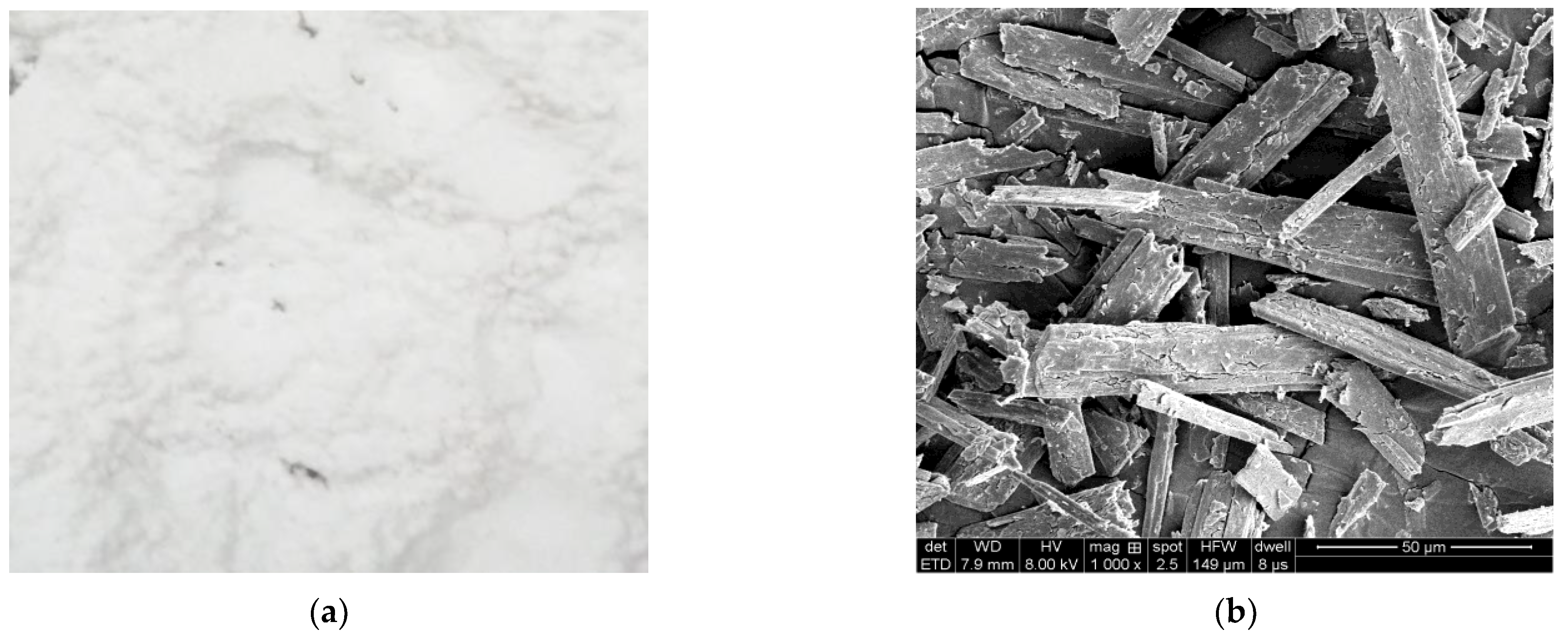

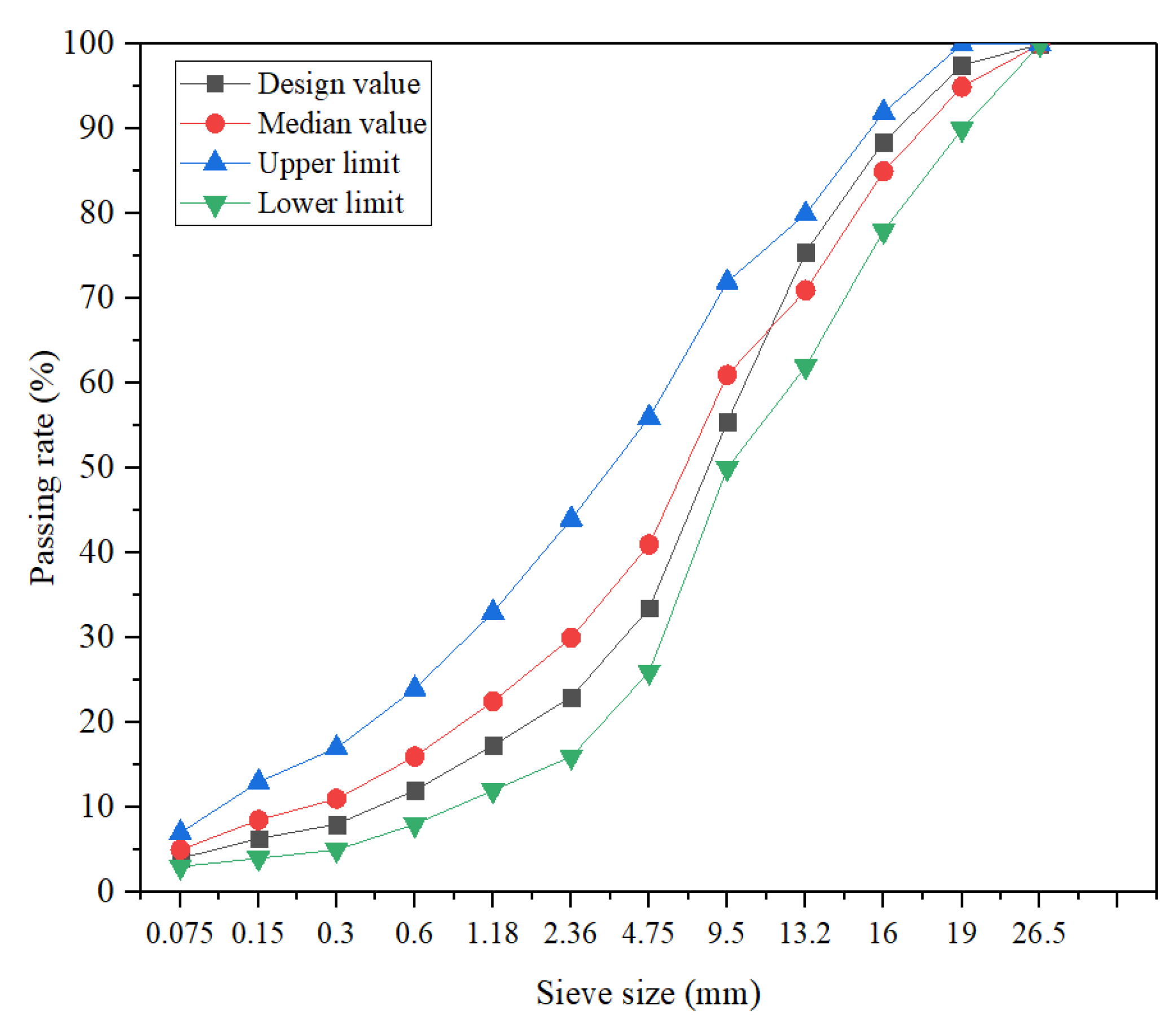
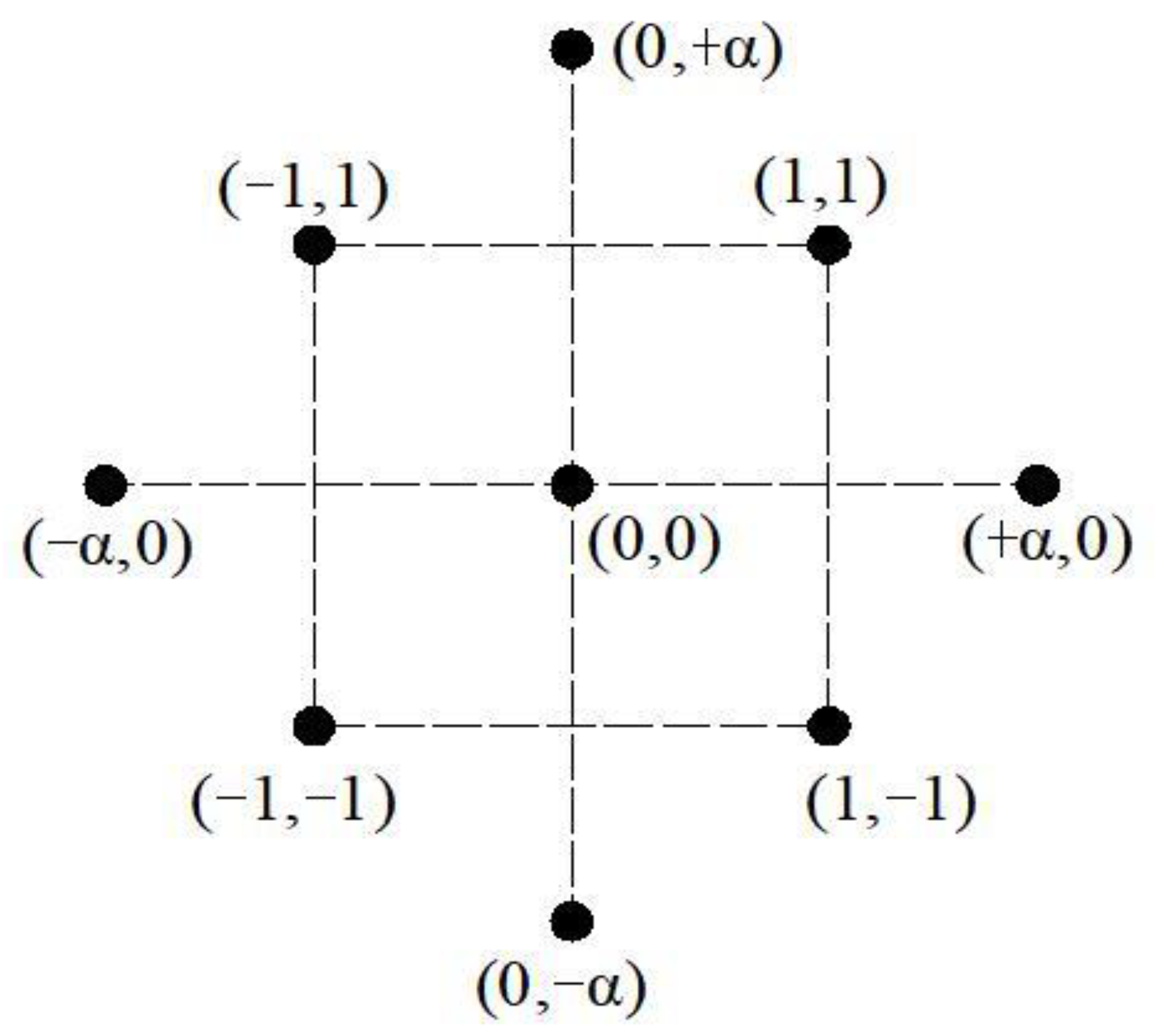
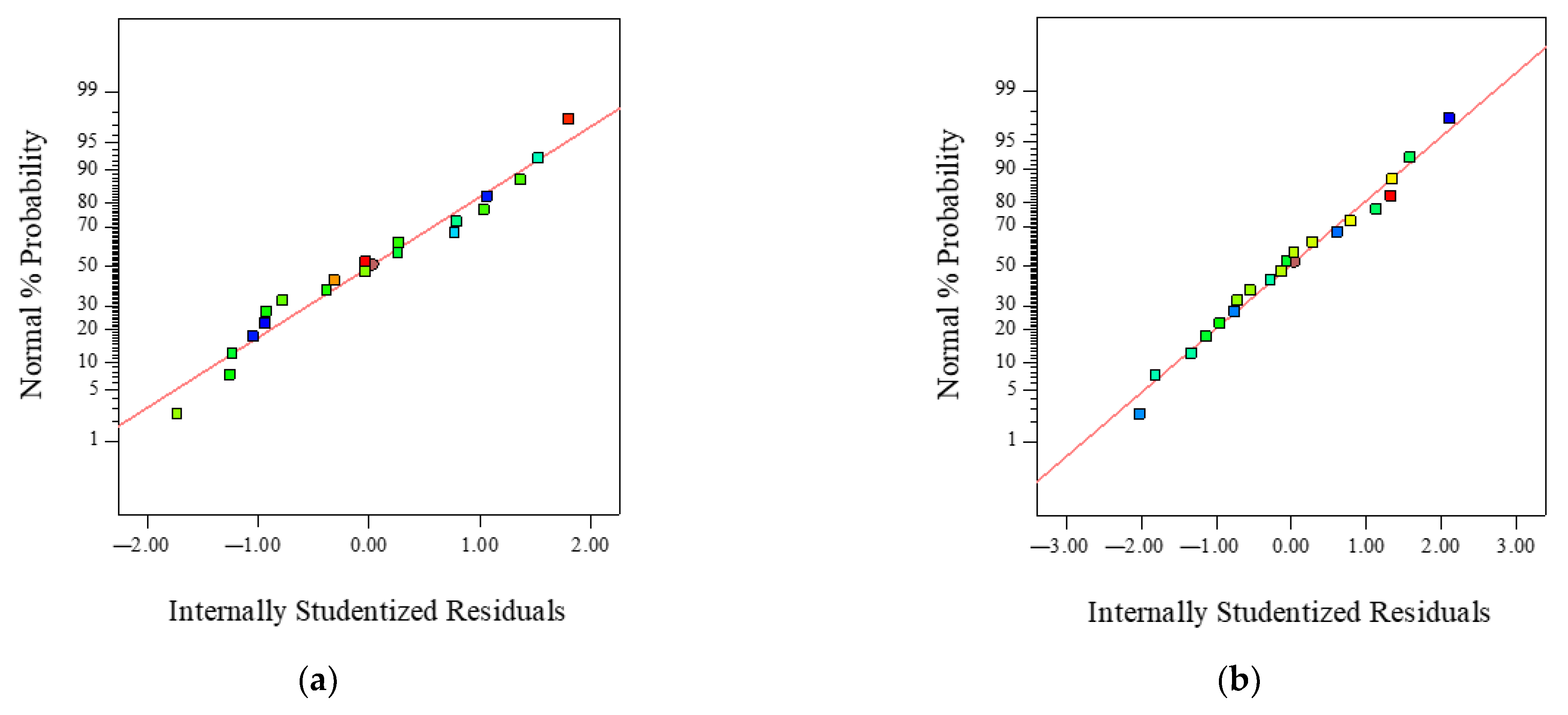
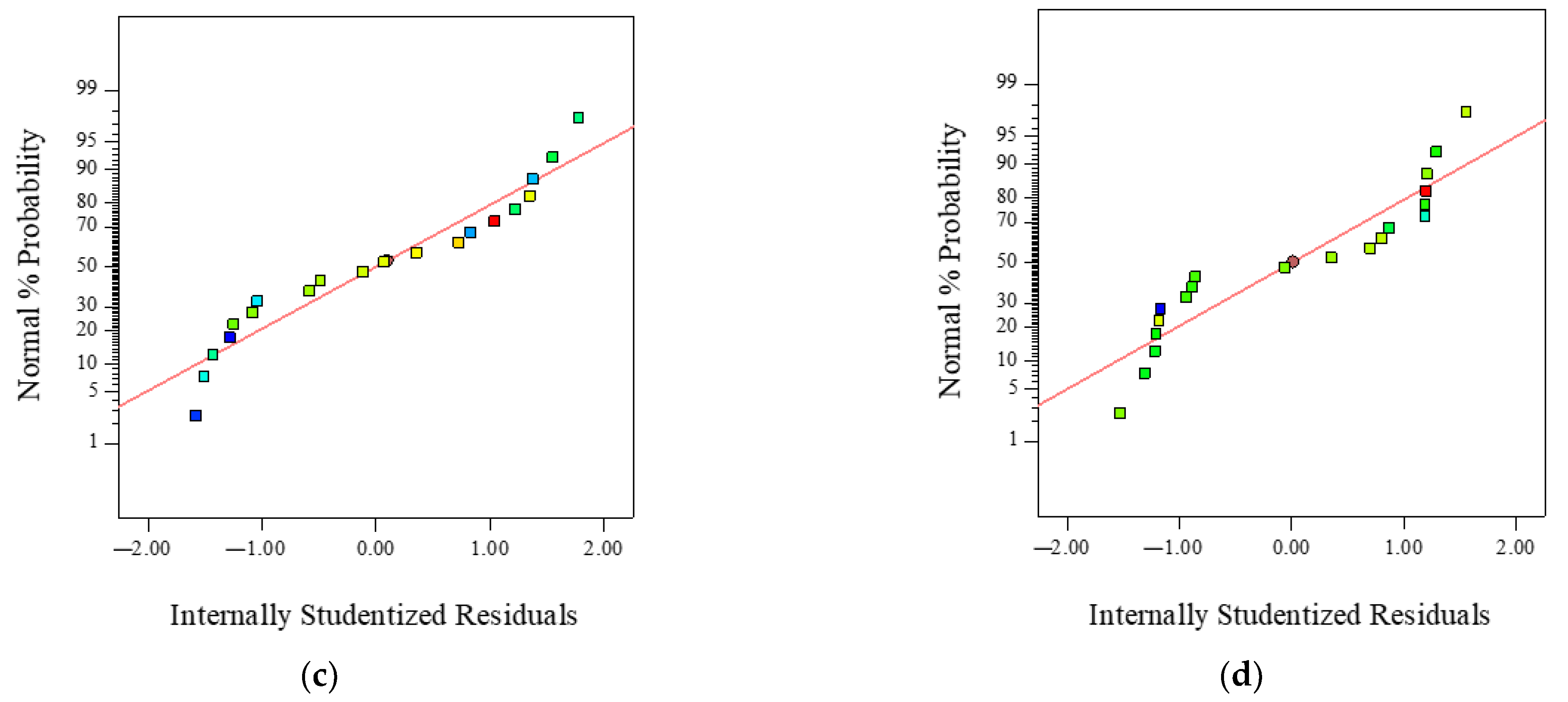
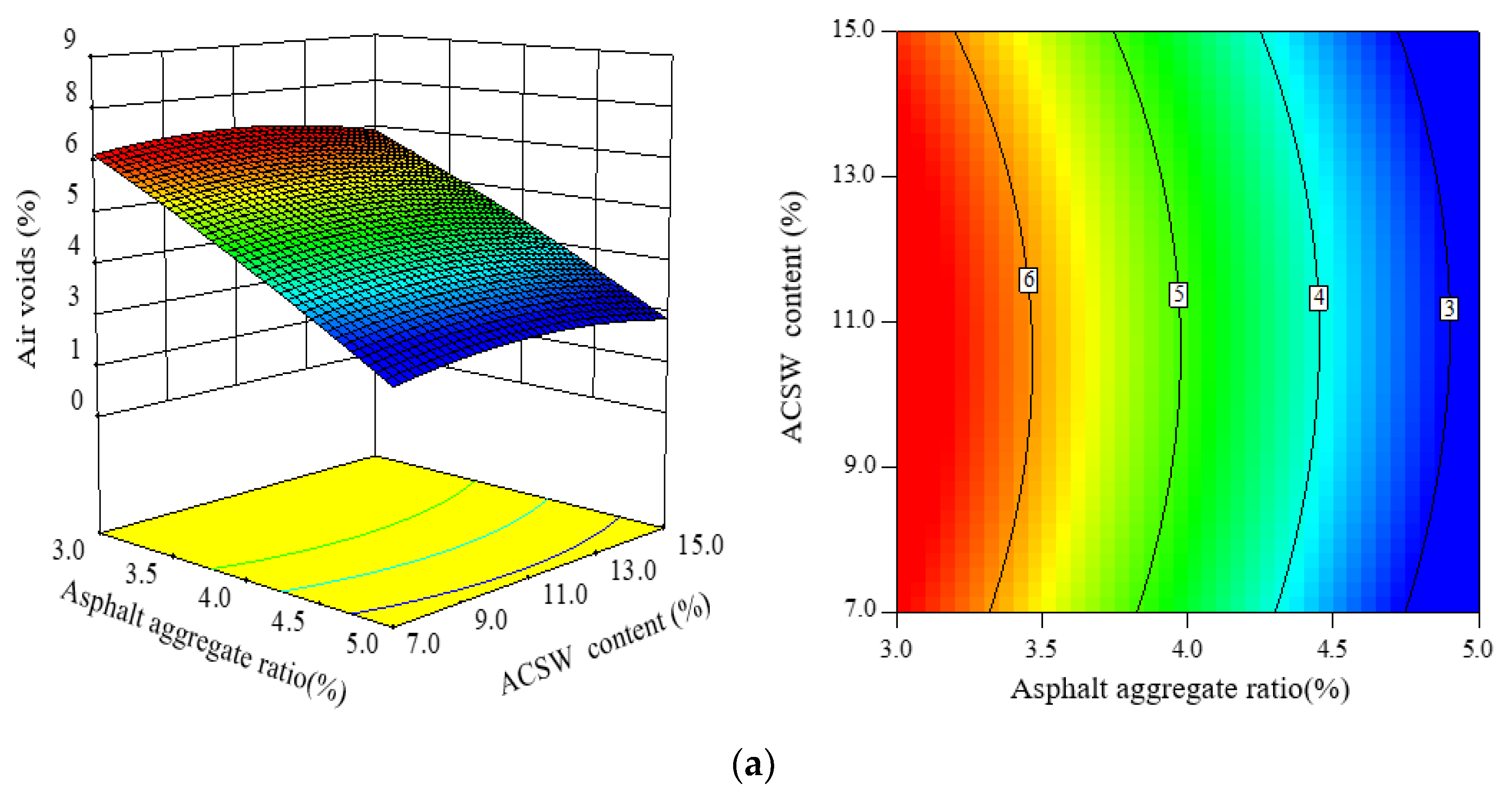

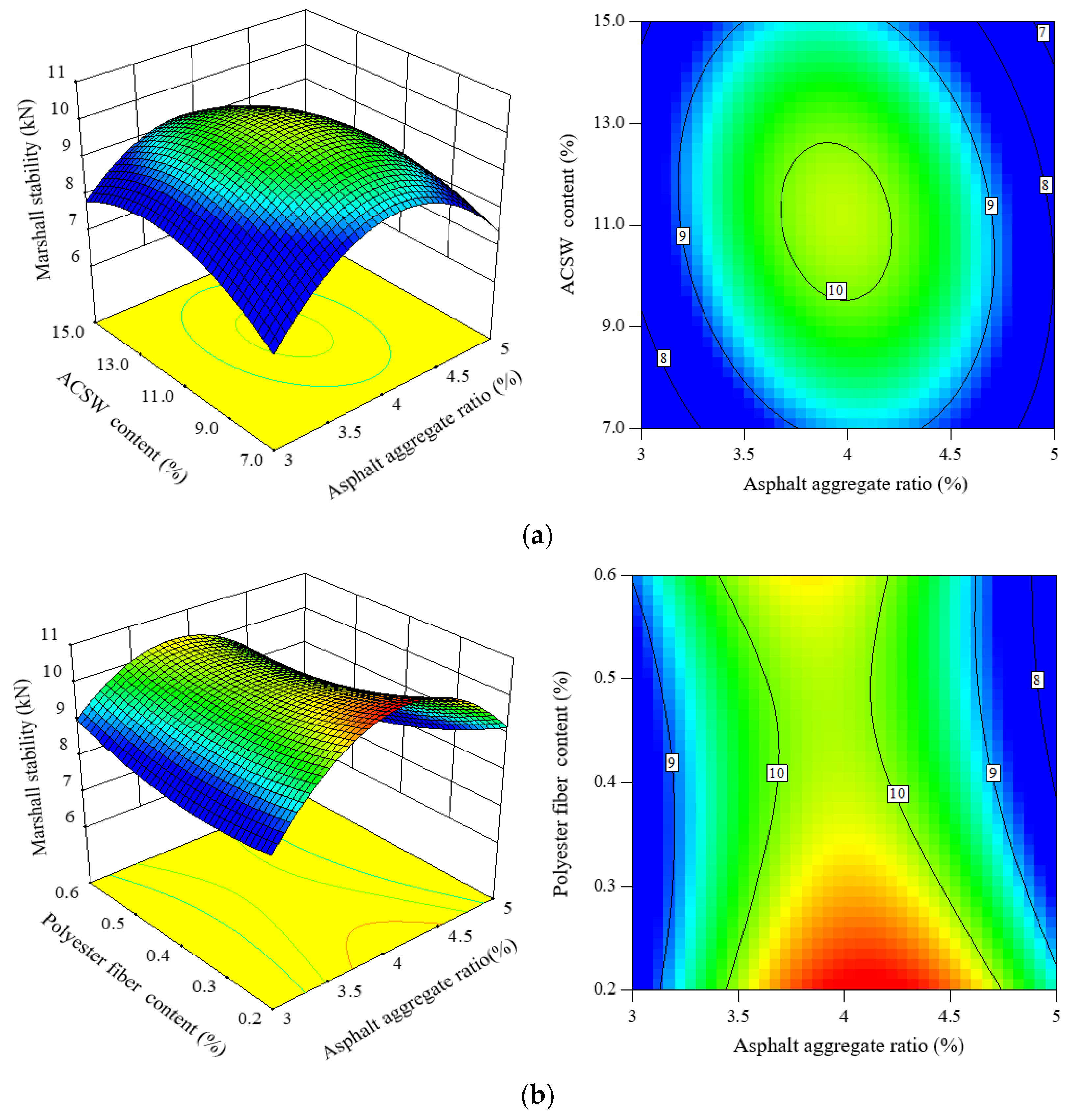
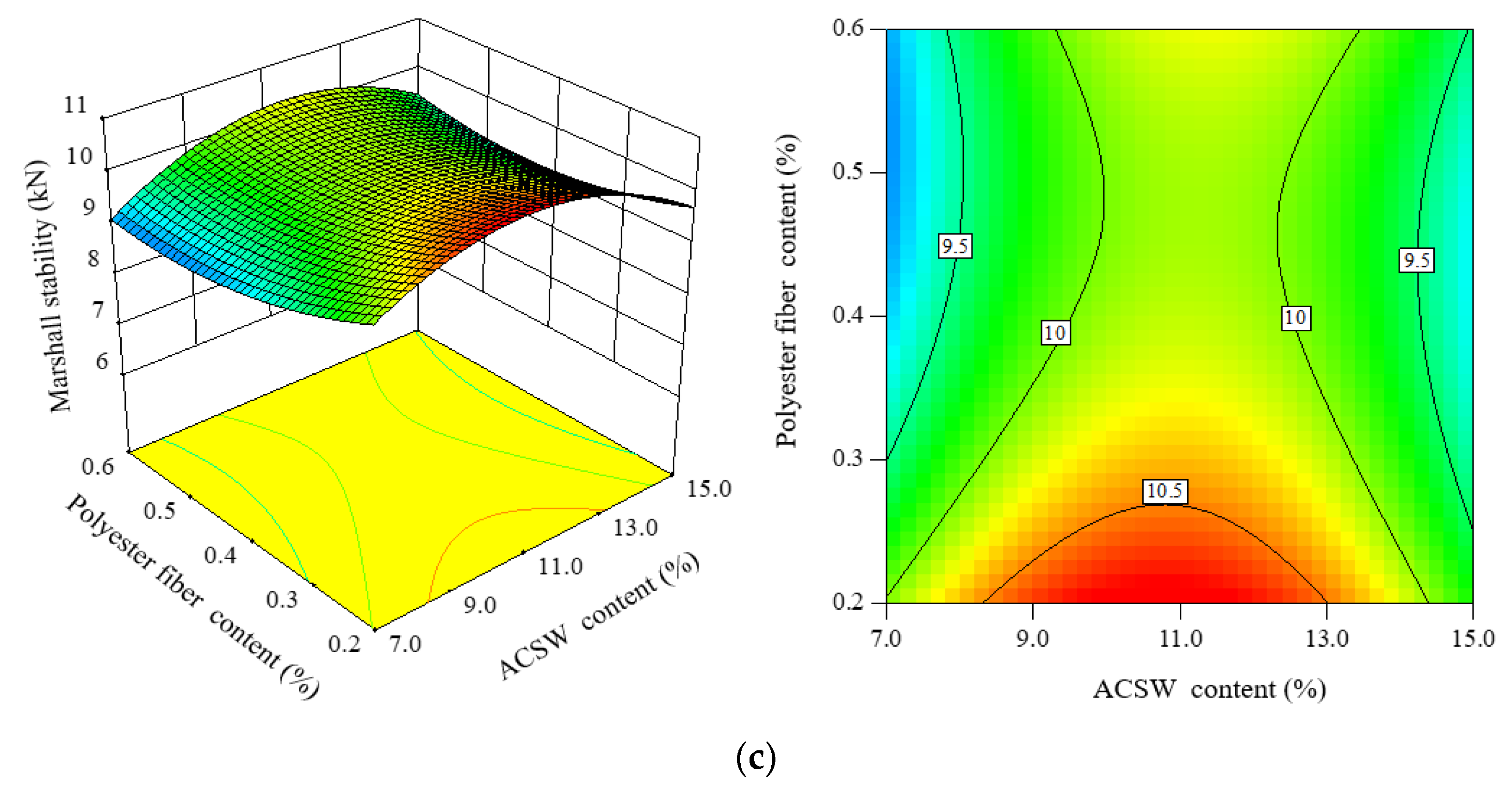
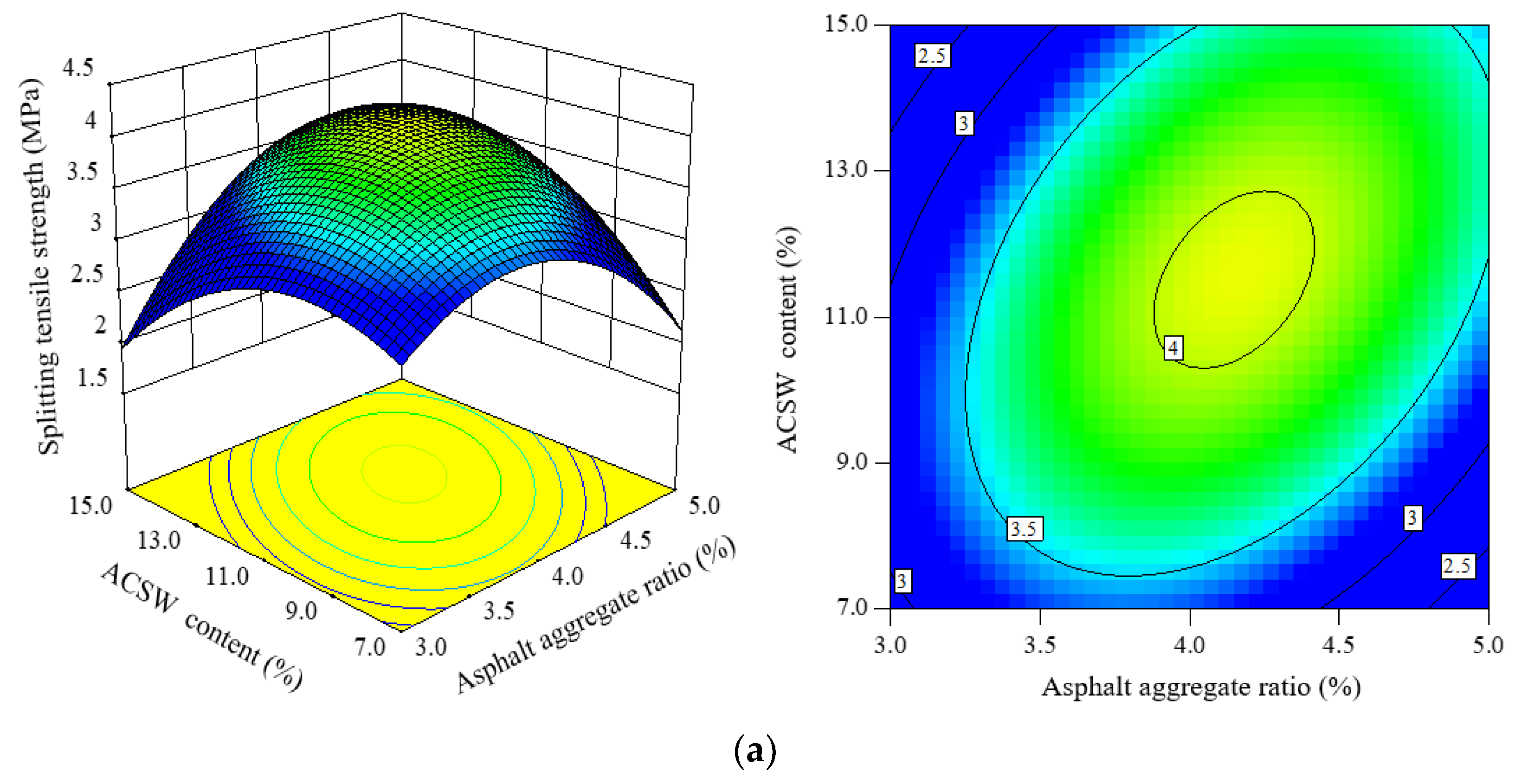
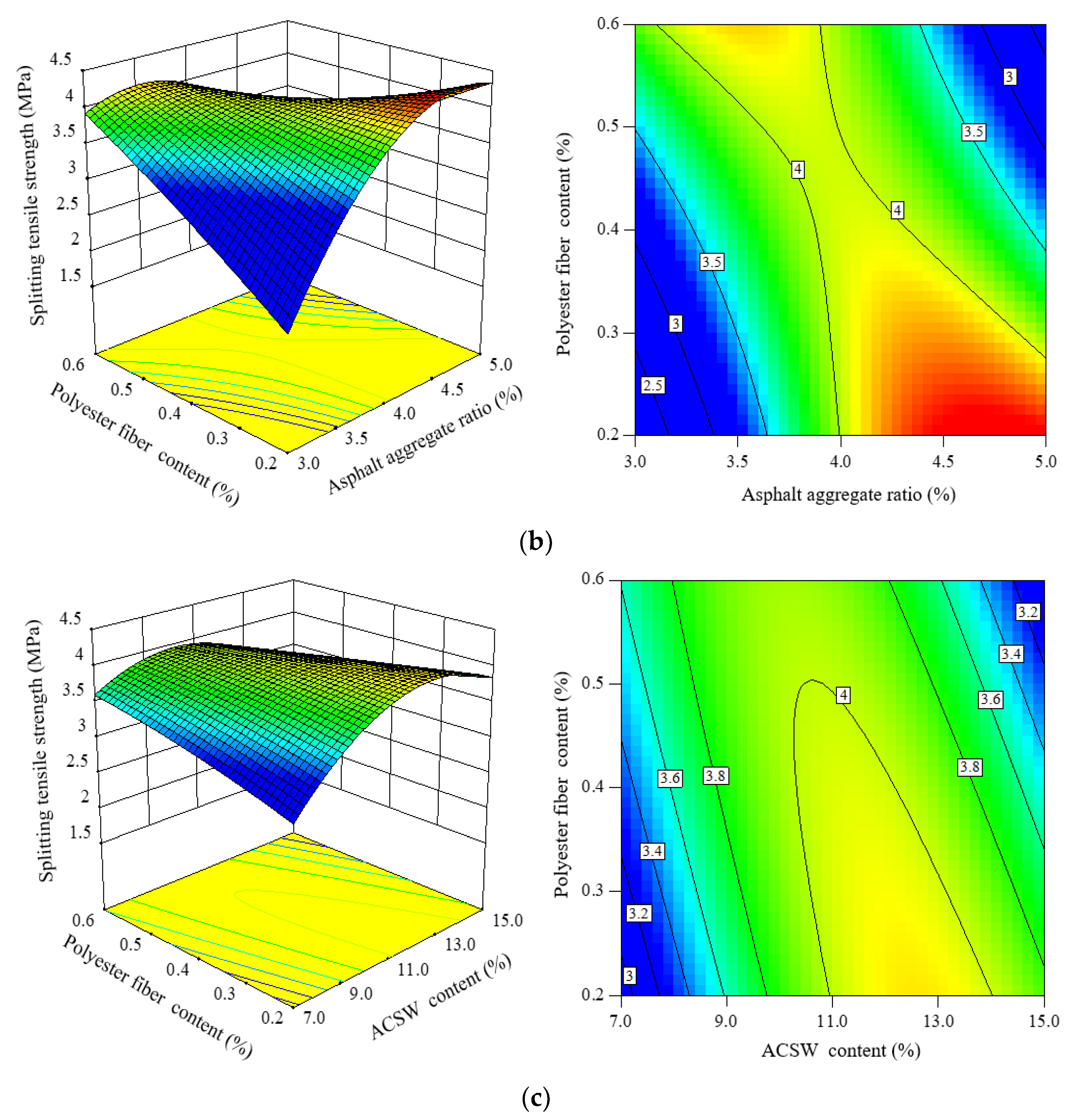
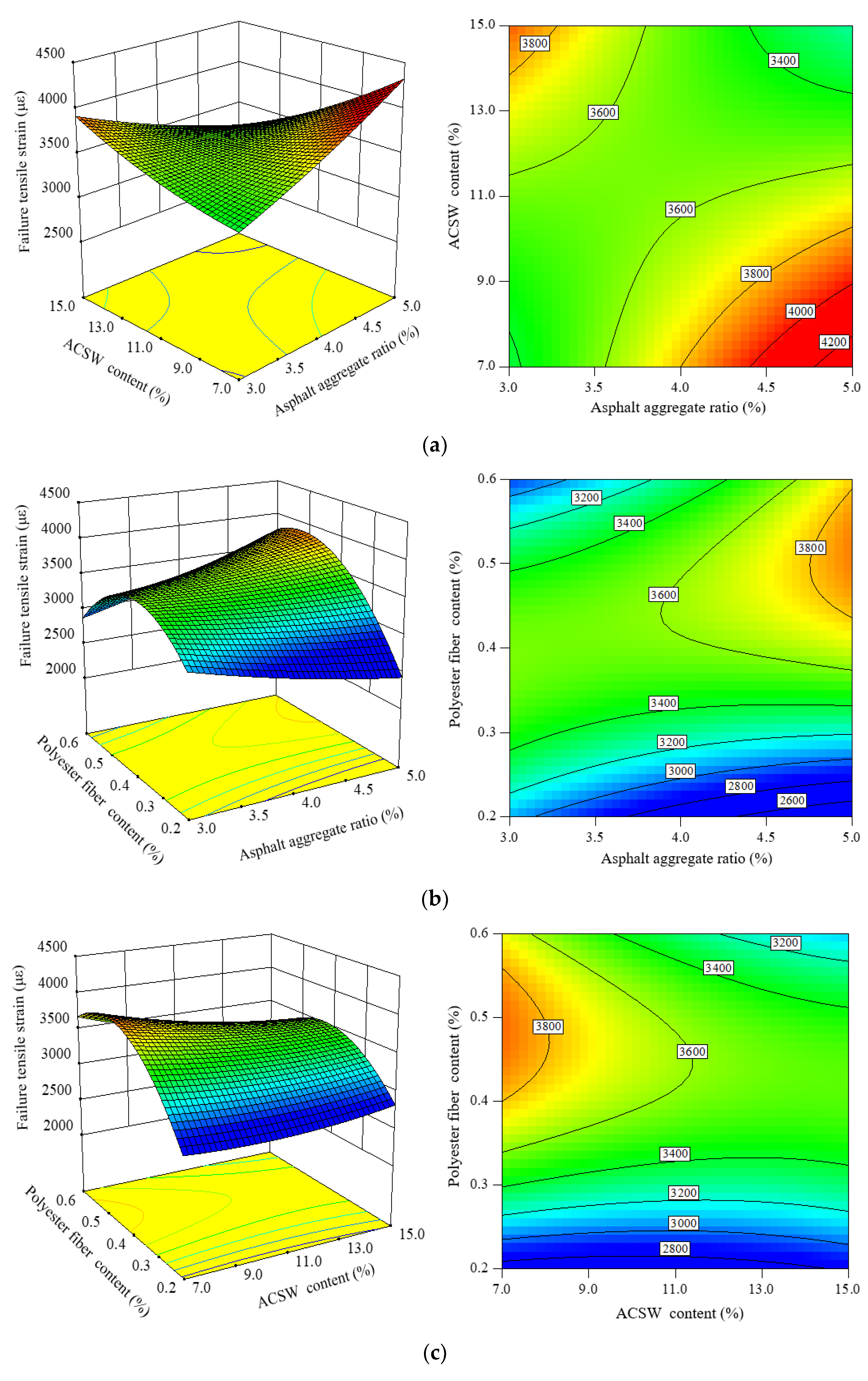

| Properties | Unit | Results | Technical Standard | Methods |
|---|---|---|---|---|
| Penetration at 25 °C | 0.1 mm | 85.9 | 80–100 | ASTM D5 |
| Softening point | °C | 46.5 | ≥45 | ASTM D36 |
| Ductility at 15 °C | cm | >100 | ≥100 | ASTM D113 |
| Viscosity at 135 °C | Pa.s | 0.344 | - | ASTM D4402 |
| RTFOT | ||||
| Penetration ratio at 25 °C | % | 68.4 | ≥57 | ASTM D5 |
| Ductility at 10 °C | cm | >100 | ≥8 | ASTM D113 |
| Index | Aggregates (mm) | |||||||||||
|---|---|---|---|---|---|---|---|---|---|---|---|---|
| 19 | 16 | 13.2 | 9.5 | 4.75 | 2.36 | 1.18 | 0.6 | 0.3 | 0.15 | 0.075 | ||
| Apparent specific gravity | 2.705 | 2.719 | 2.715 | 2.729 | 2.718 | 2.743 | 2.644 | 2.719 | 2.725 | 2.7444 | 2.584 | |
| Bulk volume relative density | 2.686 | 2.678 | 2.691 | 2.701 | 2.689 | 2.707 | 2.556 | 2.530 | 2.593 | 2.504 | 2.444 | |
| Water absorption (%) | 0.263 | 0.555 | 0.335 | 0.380 | 0.400 | 0.489 | 1.314 | 2.746 | 1.866 | 3.502 | 2.222 | |
| Passing rate (%) | Design value | 97.5 | 88.5 | 75.5 | 55.5 | 33.5 | 23.0 | 17.3 | 12.0 | 8.0 | 6.3 | 4.0 |
| Median value | 95.0 | 85.0 | 71.0 | 61.0 | 41.0 | 30.0 | 22.5 | 16.0 | 11.0 | 8.5 | 5.0 | |
| Upper limit | 100.0 | 92.0 | 80.0 | 72.0 | 56.0 | 44.0 | 33.0 | 24.0 | 17.0 | 13.0 | 7.0 | |
| Lower limit | 90.0 | 78.0 | 62.0 | 50.0 | 26.0 | 16.0 | 12.0 | 8.0 | 5.0 | 4.0 | 3.0 | |
| Index | Unit | Results | Technical Standard | |
|---|---|---|---|---|
| Apparent specific gravity | - | 2.710 | ≥2.45 | |
| Moisture absorption | % | 0.3 | ≤1 | |
| Passing rate of sieve size (mm) | <0.6 | % | 100 | 100 |
| <0.15 | % | 99.1 | 90~100 | |
| <0.075 | % | 90.4 | 70~100 | |
| Index | Morphology | Bulk Density | Length | Diameter | Aspect Ratio | Melting Point |
|---|---|---|---|---|---|---|
| Unit | - | g/cm3 | μm | μm | - | °C |
| Results | White flocculent | 0.1–0.4 | 10–200 | 1–4 | 40–100 | 1450 |
| Index | Diameter | Tensile Strength | Specific Gravity | Melting Point | Length | Elongation |
|---|---|---|---|---|---|---|
| Unit | μm | Mpa | g/cm3 | °C | mm | % |
| Results | 19–21 | 591 | 1.38 | 259 | 6 | 10.8 |
| Independent Variables | Unit | Levels | |||||
|---|---|---|---|---|---|---|---|
| −1.682 | −1 | 0 | 1 | 1.682 | |||
| X1 | AAR | % | 3.16 | 3.5 | 4 | 4.5 | 4.84 |
| X2 | ACC | % | 7.64 | 9 | 11 | 13 | 14.36 |
| X3 | PFC | % | 0.23 | 0.3 | 0.4 | 0.5 | 0.57 |
| No. | Independent Variables | Response Variables | |||||
|---|---|---|---|---|---|---|---|
| AAR X1 (%) | ACC X2 (%) | PFC X3 (%) | AV Y1 (%) | MS Y2 (kN) | STS Y3 (MPa) | FTS Y4 (με) | |
| 1 | 3.5 | 13 | 0.3 | 5.28 | 9.67 | 3.44 | 3396.87 |
| 2 | 4.5 | 9 | 0.5 | 4.35 | 9.01 | 3.29 | 4020.81 |
| 3 | 3.5 | 13 | 0.5 | 6.03 | 9.67 | 3.68 | 3408.90 |
| 4 | 4.0 | 11 | 0.4 | 4.97 | 10.23 | 4.07 | 3577.08 |
| 5 | 3.5 | 9 | 0.3 | 5.16 | 9.43 | 3.41 | 3348.46 |
| 6 | 4.0 | 11 | 0.4 | 4.91 | 10.14 | 3.98 | 3651.07 |
| 7 | 4.0 | 11 | 0.4 | 4.83 | 10.12 | 4.02 | 3508.28 |
| 8 | 4.0 | 11 | 0.23 | 3.81 | 10.78 | 3.94 | 2835.41 |
| 9 | 4.0 | 14.36 | 0.4 | 4.64 | 9.56 | 3.54 | 3596.77 |
| 10 | 4.0 | 11 | 0.4 | 5.04 | 10.05 | 4.04 | 3612.56 |
| 11 | 3.5 | 9 | 0.5 | 6.42 | 9.42 | 3.91 | 3428.67 |
| 12 | 4.5 | 13 | 0.5 | 4.18 | 8.99 | 3.49 | 3475.10 |
| 13 | 4.84 | 11 | 0.4 | 3.08 | 8.73 | 3.72 | 3583.14 |
| 14 | 4.5 | 9 | 0.3 | 3.16 | 9.76 | 3.63 | 3452.90 |
| 15 | 4.0 | 11 | 0.57 | 5.33 | 10.29 | 4.05 | 3466.78 |
| 16 | 4.0 | 11 | 0.4 | 5.07 | 10.17 | 3.97 | 3642.15 |
| 17 | 3.16 | 11 | 0.4 | 6.55 | 8.95 | 3.23 | 3652.81 |
| 18 | 4.5 | 13 | 0.3 | 3.17 | 9.40 | 4.35 | 3198.94 |
| 19 | 4.0 | 7.64 | 0.4 | 4.66 | 9.58 | 3.65 | 3684.61 |
| 20 | 4.0 | 11 | 0.4 | 4.86 | 10.07 | 4.11 | 3501.16 |
| Responses | R-Squared | Adj. R-Squared | Adeq. Precision | F-Value | p-Value | Significant | |
|---|---|---|---|---|---|---|---|
| Y1 | AV | 0.9943 | 0.9893 | 48.525 | 195.43 | <0.0001 | yes |
| Y2 | MS | 0.9683 | 0.9398 | 22.869 | 33.95 | <0.0001 | yes |
| Y3 | STS | 0.9245 | 0.8565 | 11.512 | 13.60 | 0.0002 | yes |
| Y4 | FTS | 0.9106 | 0.8302 | 15.810 | 11.32 | 0.0004 | yes |
| Responses | Factors | Sum of Squares | Degree of Freedom | Mean Square | F-Value | p-Value | Significant |
|---|---|---|---|---|---|---|---|
| AV | X1 | 14.08 | 1 | 14.08 | 1418.02 | <0.0001 | yes |
| X2 | 0.016 | 1 | 0.016 | 1.59 | 0.2366 | no | |
| X3 | 3.35 | 1 | 3.350 | 337.67 | <0.0001 | yes | |
| X1X2 | 0.0015 | 1 | 0.0015 | 0.15 | 0.7045 | no | |
| X1X3 | 0.0045 | 1 | 0.0045 | 0.45 | 0.5155 | no | |
| X2X3 | 0.060 | 1 | 0.060 | 5.99 | 0.0344 | yes | |
| X12 | 0.017 | 1 | 0.017 | 1.74 | 0.2170 | no | |
| X22 | 0.120 | 1 | 0.120 | 12.53 | 0.0054 | yes | |
| X32 | 0.210 | 1 | 0.210 | 21.33 | 0.0010 | yes | |
| Lack of Fit | 0.052 | 5 | 0.010 | 1.12 | 0.4538 | no | |
| MS | X1 | 0.14 | 1 | 0.14 | 8.05 | 0.0176 | yes |
| X2 | 0.0004 | 1 | 0.0004 | 0.024 | 0.8801 | no | |
| X3 | 0.29 | 1 | 0.29 | 16.34 | 0.0024 | yes | |
| X1X2 | 0.095 | 1 | 0.095 | 5.31 | 0.0439 | yes | |
| X1X3 | 0.17 | 1 | 0.17 | 9.28 | 0.0123 | yes | |
| X2X3 | 0.015 | 1 | 0.015 | 0.86 | 0.3758 | no | |
| X12 | 3.58 | 1 | 3.58 | 200.85 | <0.0001 | yes | |
| X22 | 0.83 | 1 | 0.83 | 46.68 | <0.0001 | yes | |
| X32 | 0.15 | 1 | 0.15 | 8.23 | 0.0167 | yes | |
| Lack of Fit | 0.071 | 5 | 0.014 | 3.17 | 0.1156 | no | |
| STS | X1 | 0.096 | 1 | 0.096 | 6.97 | 0.0248 | yes |
| X2 | 0.021 | 1 | 0.021 | 1.52 | 0.2453 | no | |
| X3 | 0.0055 | 1 | 0.0055 | 0.40 | 0.5400 | no | |
| X1X2 | 0.16 | 1 | 0.16 | 11.40 | 0.0070 | yes | |
| X1X3 | 0.47 | 1 | 0.47 | 34.20 | 0.0002 | yes | |
| X2X3 | 0.076 | 1 | 0.076 | 5.53 | 0.0406 | yes | |
| X12 | 0.58 | 1 | 0.58 | 42.11 | <0.0001 | yes | |
| X22 | 0.36 | 1 | 0.36 | 26.18 | 0.0005 | yes | |
| X32 | 0.004 | 1 | 0.004 | 0.29 | 0.6016 | no | |
| Lack of Fit | 0.033 | 5 | 0.0066 | 2.38 | 0.1816 | no | |
| FTS | X1 | 1.5271 × 104 | 1 | 1.5271 × 104 | 1.71 | 0.2204 | no |
| X2 | 6.3025 × 104 | 1 | 6.3025 × 104 | 7.05 | 0.0241 | yes | |
| X3 | 2.897 × 105 | 1 | 2.897 × 105 | 32.42 | 0.0002 | yes | |
| X1X2 | 8.3908 × 104 | 1 | 8.3908 × 104 | 9.39 | 0.0120 | yes | |
| X1X3 | 7.2357 × 104 | 1 | 7.2357 × 104 | 8.10 | 0.0174 | yes | |
| X2X3 | 1.7013 × 104 | 1 | 1.7013 × 104 | 1.90 | 0.1977 | no | |
| X12 | 2489.02 | 1 | 2489.02 | 0.28 | 0.6092 | no | |
| X22 | 6460.53 | 1 | 6460.53 | 0.72 | 0.4151 | no | |
| X32 | 3.326 × 105 | 1 | 3.326 × 105 | 37.22 | 0.0001 | yes | |
| Lack of Fit | 6.8055 × 104 | 5 | 1.3611 × 104 | 3.19 | 0.1142 | no |
| Response | AV(Y1) | MS(Y2) | STS(Y3) | FTS(Y4) |
|---|---|---|---|---|
| Unit | % | kN | MPa | με |
| Target values | 4–5 | Maximize | Maximize | Maximize |
| Project | Unit | Predicted Values | Laboratory Values | Deviation Rate (%) |
|---|---|---|---|---|
| AAR(X1) | % | 4.0 | 4.0 | |
| ACC(X2) | % | 10.8 | 10.8 | |
| PFC(X3) | % | 0.4 | 0.4 | |
| AV(Y1) | % | 5.00 | 5.04 | 0.79 |
| MS(Y2) | kN | 10.11 | 10.05 | −0.60 |
| STS(Y3) | MPa | 4.01 | 4.03 | 0.50 |
| FTS(Y4) | με | 3637.09 | 3640.2 | 0.09 |
Disclaimer/Publisher’s Note: The statements, opinions and data contained in all publications are solely those of the individual author(s) and contributor(s) and not of MDPI and/or the editor(s). MDPI and/or the editor(s) disclaim responsibility for any injury to people or property resulting from any ideas, methods, instructions or products referred to in the content. |
© 2023 by the authors. Licensee MDPI, Basel, Switzerland. This article is an open access article distributed under the terms and conditions of the Creative Commons Attribution (CC BY) license (https://creativecommons.org/licenses/by/4.0/).
Share and Cite
Fan, T.; Si, C.; Zhang, Y.; Zhu, Y.; Li, S. Optimization Design of Asphalt Mixture Composite Reinforced with Calcium Sulfate Anhydrous Whisker and Polyester Fiber Based on Response Surface Methodology. Materials 2023, 16, 594. https://doi.org/10.3390/ma16020594
Fan T, Si C, Zhang Y, Zhu Y, Li S. Optimization Design of Asphalt Mixture Composite Reinforced with Calcium Sulfate Anhydrous Whisker and Polyester Fiber Based on Response Surface Methodology. Materials. 2023; 16(2):594. https://doi.org/10.3390/ma16020594
Chicago/Turabian StyleFan, Taotao, Chundi Si, Yi Zhang, Yuefeng Zhu, and Song Li. 2023. "Optimization Design of Asphalt Mixture Composite Reinforced with Calcium Sulfate Anhydrous Whisker and Polyester Fiber Based on Response Surface Methodology" Materials 16, no. 2: 594. https://doi.org/10.3390/ma16020594
APA StyleFan, T., Si, C., Zhang, Y., Zhu, Y., & Li, S. (2023). Optimization Design of Asphalt Mixture Composite Reinforced with Calcium Sulfate Anhydrous Whisker and Polyester Fiber Based on Response Surface Methodology. Materials, 16(2), 594. https://doi.org/10.3390/ma16020594






